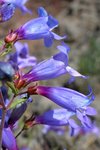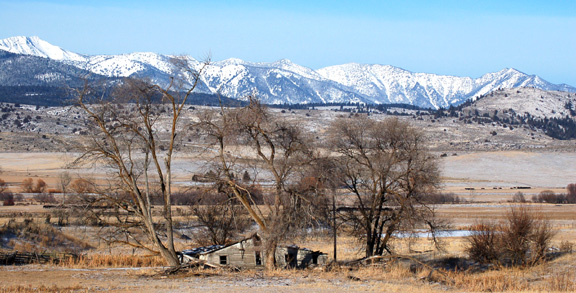- Wallowa Mountains Wildflowers, Part 1
- Hells Canyon/Payette N F Sheep Decision
__________
Wallowa Mountains Wildflowers, Part 1
The closure of the Forest Service 39 Road, due to spring flooding, has left the 66 road via the 6625 road as the only “convenient” way for Baker County residents to get into the upper Hells Canyon country. This month I found some time to visit portions of that route to Fish Lake, Twin Lakes, and beyond. Along the way there were opportunities for photographing some of the common wildflowers along the route, and this is the first part of a long chronicle of common wildflowers that are easily found.
 Showy Milkweed (Asclepias speciosa)
Showy Milkweed (Asclepias speciosa)As you travel along Highway 86, both east and west of Richland, patches of both light, and dark pink flowered “showy milkweed” (Asclepias speciosa) begin to crop up along the highway. As the name indicates, this particular milkweed flower is one of the prettiest and noticeable, with a strong, perfume-like fragrance.. It is also structured quite differently, as are the other milkweeds, than most of the flowers one encounters. As the second part of the common name indicates, it exudes a sticky milk-white sap from injured portions of the plant where the epidermis has been cracked or cut.
 Showy Milkweed (Asclepias speciosa)
Showy Milkweed (Asclepias speciosa)One downside to this plant, from the perspective of stock raisers, is that all parts of the plant are poisonous, even when dry. It can cause sickness or death in cattle, sheep, and horses (and Humans) when ingested in large enough quantities.
At least one family of animals, the milkweed butterflies, of which the Monarch butterfly is one, depends upon milkweeds for their survival (bees nd other flying insects also utilize this plant). The larvae (caterpillars) feed on the milkweed plant and concentrate the various poisons in their bodies, thus becoming very distasteful to birds and other predators. This quality causes avoidance behavior in the would-be consumers, and allows the milkweed butterflies to go about their business un-harassed. Given the monarch’s long and difficult migration between Central Mexico or the coast of California and other areas in the U.S. and Canada, their adaptation to and relationship with milkweeds provides them with certain needed advantages unknown to many other butterflies. Some butterflies, like the Viceroy, mimic the color and pattern of the milkweed butterflies which helps to cause birds to leave them alone as well.
 Close-up of Showy Milkweed flower
Close-up of Showy Milkweed flowerFurther east past Richland, around the crest of Halfway Hill (about 3500’), both “Lewis' mock orange” (Philadelphus lewisii), and “Venus Penstemon” (Penstemon venustus) can be found blooming from mid to late June and on into July. Mock orange is commonly used in residential planting throughout the North West, including Baker City. Venus Penstemon is seeing increasing use locally by native plant gardeners.
 Lewis' Mock Orange (Philadelphus lewisii)
Lewis' Mock Orange (Philadelphus lewisii)The scientific name for Mock Orange, lewisii, is for its first documented American discoverer (of European origins that is), Meriwether Lewis. It is one of many plants "discovered" during the Lewis and Clark expedition. The common name is in reference to its white flowers and sweet fragrance, which to some resemble the blossoms of the orange citrus tree.
 Lewis' Mock Orange (Philadelphus lewisii)
Lewis' Mock Orange (Philadelphus lewisii)Venus Penstemon (Penstemon venustus) belongs to a large, primarily North American genus of over 250 species, all of whom are very attractive, with many being useful to moths, bees and hummingbirds. Several are also useful horticulturally, although some can be short-lived (about 2-3 years, longer in suitable conditions, and some of the shrubby penstemons apparently live quite a long while.). Penstemons (apparently a reference to the five stamens), or beardtongues as they are also known (due to the presence of a fifth stamen, the staminode, which is hairy or bearded in many species, and the “bearded” lower lips of many Penstemons. They resemble the common garden snapdragon, and are just as easy to look at.
 Venus Penstemon (Penstemon venustus)
Venus Penstemon (Penstemon venustus)Many more Venus Penstemons can be found in the canyon along North Pine Creek adjacent to the 39 Road, and on up the road to the Hells Canyon Rim. They are fairly common in the Wallowa Mountains.
Beginning in the ponderosa pine and mixed conifer forests not far out of Halfway, and continuing sporadically on up into the sub-alpine forest, are yet three more eye-catching wildflowers.
 Tapertip or Hooker’s onion (Allium acuminatum)
Tapertip or Hooker’s onion (Allium acuminatum)The first to be encountered will likely be the Tapertip or Hooker’s onion (Allium acuminatum). This onion, with the characteristic odor of the genus, is fairly easy to distinguish from other local alliums due to its fuchia (rose-purple?) colored “petals” (tepals) with rather abruptly narrowed (acuminate) tips. Occasionally they are pink and rarely, white. Under the magnifying glass or dissecting scope, one can see the tiny teeth like projections which line the edges of the smaller inner tepals. The small onion bulbs were cooked and eaten by the Native Americans and no doubt by early settlers, as well as a few curious botanists and campers.
 Tapertip or Hooker’s onion (Allium acuminatum)
Tapertip or Hooker’s onion (Allium acuminatum)The second wildflower might likely be one of the west’s all-star wildflowers, Scarlet Gilia (Ipomopsis aggregata). This tough and spectacular little biennial, graces much of the west, from the arid foothills of the Great Basin and North East Oregon to the more moist sub-alpine zones throughout the area. I have found this plant blooming even on dry exposed hillsides in conditions of drought, so it does well in the semi-dry garden situation.
 Scarlet Gilia (Ipomopsis aggregata)
Scarlet Gilia (Ipomopsis aggregata)Beginning near the transition to primarily sub-alpine vegetation, the third plant, a beautiful and seemingly delicate Penstemon appears; Wilcox’s Penstemon (Penstemon wilcoxii).
 Wilcox’s Penstemon (Penstemon wilcoxii)
Wilcox’s Penstemon (Penstemon wilcoxii)To my knowledge, Wilcox’s Penstemon is only found in Oregon in the eastern Wallowa Mountains and along the Hells Canyon Rim, where it is quite common. It is closely related to Penstmon albertinus of central and eastern Idaho (for example, around the Sawtooth Mountains), and western Montana where the two species intergrade. It also appears to be related to Penstemon ovatus of western Washington and extreme north western Oregon.
 Wilcox’s Penstemon
Wilcox’s PenstemonAt about the same elevation, on southerly looking exposed slopes, will be found an early successional forest shrub that colonizes areas after forest fires and other major disturbances called Snowbrush Ceanothus (Ceanothus velutinus). After conifers, such as ponderosa pine, reestablish themselves, and shade out the Ceanothus, they pretty much disappear, but their seeds remain in the soil for long periods, to sprout again after the next disturbance. They are especially adapted to take advantage of fire.
 Snowbrush Ceanothus (Ceanothus velutinus)
Snowbrush Ceanothus (Ceanothus velutinus)Further up on the 66 road to Fish Lake, at about 6300 feet, there is another common perennial wildflower that was in bloom on July 7th, Arrowleaf Balsamroot (Balsamorhiza sagittata).
 Arrowleaf Balsamroot (Balsamorhiza sagittata)
Arrowleaf Balsamroot (Balsamorhiza sagittata)Arrowleaf Balsamroot is one of the commonly viewed spring and early summer flowering perennials in Baker County. It can be found blooming earlier in the foothills over most of the County, including the Snake river Canyon, and the bloom persists into the summer in the higher elevations. Some still remain on the high ridges beyond Twin Lakes, but the lack of moisture after a wet spring is causing an early end to the bloom of this and other flowering species. Hopefully the recent summer thunderstorms will prolong the blooming period.
For more information on this common wildflower and others, see:
USDA Forest Service “Celebrating Wildflowers”
Another common perennial found here and on up into the sub-alpine zone is Sitka Valerian (Valeriana sitchensis)
 Sitka Valerian (Valeriana sitchensis)
Sitka Valerian (Valeriana sitchensis)Valerian has been used to calm the nervous system. I am going to prescribe it for myself, Councilor Milo Pope, and others who are easily agitated. ;-)
For more information on Sitka valerian, please see this link:
Sitka Valerian
About a mile or so below Fish Lake, another most pleasing Penstemon appears; Globe Penstemon (Penstemon globosus).
 Globe Penstemon (Penstemon globosus)
Globe Penstemon (Penstemon globosus)They begin along the 66 road at around 6300 feet and extend their range well up into the sub-alpine zone.
One of my favorite small to medium sized flowering Penstemons, they are quite adaptable to gardens where adequate sunshine, space (from weeds) and moisture is provided. They are primarily an Idaho species, but extend into Baker County and the south eastern reaches of Wallowa County from north of Halfway and east to the Hells Canyon Rim.
 Globe Penstemon (Penstemon globosus)
Globe Penstemon (Penstemon globosus)That’s about all the time and space for Wallowa Mountains wildflowers I have for part one of this series. Hope to continue it in future blogs.
_____
Hells Canyon/Payette N F Sheep Decision
The Payette National Forest has issued a decision, a four year transitional plan to cut back domestic sheep grazing in areas near Hells Canyon and the Salmon River of Idaho. There is no reduction the first year, and then three years of reductions beginning with the next grazing season. The Rocky Mountain bighorn sheep populations there and on the Oregon side of the Snake River have been decimated due to the transmission of disease from domestic sheep. The disease organisms involved—there are several—such as Mannheimia haemolytica, can cause chronic respiratory problems leading to fatal pneumonia in bighorn. The full plan will be implemented by the 2013 grazing season.
 Rocky Mountain Bighorn Sheep (Idaho Dept. of Fish & Game)
Rocky Mountain Bighorn Sheep (Idaho Dept. of Fish & Game)Here is one announcement, from Western Watersheds Project, the Hailey, Idaho based environmental watchdog, led by Jon Marvel, who has been so instrumental in educating people about, and organizing effective legal resistance to, the environmental devastation wrought by livestock grazing on our western public lands.
From Western Watersheds:
“Western Watersheds Project Pressure Pays Off: The Payette National Forest Cuts Domestic Sheep Grazing By 65% to Protect Bighorn Sheep
Friends,
Western Watersheds Project has worked for several years now to protect bighorn sheep across the west. With excellent legal assistance from attorney Laurie Rule at the Boise office of
Advocates for the West (http://www.advocateswest.org/), Western Watersheds Project’s efforts are now showing success through an unprecedented Payette National Forest decision released on July 26, 2010.
The decision is a direct consequence of litigation brought by WWP and our conservation partners at the Hells Canyon Preservation Council .
The Payette Forest decision closes hundreds of thousands of acres of public land to grazing by domestic sheep to protect Rocky Mountain bighorn sheep from fatal diseases transmitted to bighorns by domestic sheep. The total reduction in domestic sheep use on the Payette National Forest will be about 65% of currently permitted domestic sheep grazing, and the remaining use will probably become uneconomic for ranching.
This change in Forest Service management is a huge step in the right direction, and it will cause changes in domestic sheep grazing offices across the west as it becomes the gold-standard for protecting bighorn sheep.
Western Watersheds Project predicts that within five years all domestic sheep grazing taking place within 50 miles of bighorn sheep on public lands will be stopped!"
Record of Decision.
See Also: Payette aims to cut sheep grazing by 70%












No comments:
Post a Comment